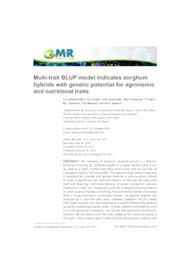Multi-trait BLUP model indicates sorghum hybrids with genetic potential for agronomic and nutritional traits.
Multi-trait BLUP model indicates sorghum hybrids with genetic potential for agronomic and nutritional traits.
Author(s): ALMEIDA FILHO, J. E.; TARDIN, F. D.; GUIMARAES, J. F. R.; RESENDE, M. D. V.; SILVA, F. F.; SIMEONE, M. L. F.; MENEZES, C. B. de; QUEIROZ, V. A. V.
Summary: The breeding of sorghum, Sorghum bicolor (L.) Moench, aimed at improving its nutritional quality, is of great interest, since it can be used as a highly nutritive alternative food source and can possibly be cultivated in regions with low rainfall. The objective of the present study was to evaluate the potential and genetic diversity of grain-sorghum hybrids for traits of agronomic and nutritional interest. To this end, the traits grain yield and flowering, and concentrations of protein, potassium, calcium, magnesium, sulfur, iron, manganese, and zinc in the grain were evaluated in 25 grain-sorghum hybrids, comprising 18 experimental hybrids of Embrapa Milho e Sorgo and seven commercial hybrids. The genetic potential was analyzed by a multi-trait best linear unbiased prediction (BLUP) model, and cluster analysis was accomplished by squared Mahalanobis distance using the predicted genotypic values. Hybrids 0306037 and 0306034 stood out in the agronomic evaluation. The hybrids with agronomic prominence, however, did not stand out for the traits related to the nutritional quality of the grain. Three clusters were formed from the dendrogram obtained with the unweighted pair group method with arithmetic mean method. From the results of the genotypic BLUP and the analysis of the dendrogram, hybrids 0577337, 0441347, 0307651, and 0306037 were identified as having the potential to establish a population that can aggregate alleles for all the evaluated traits of interest
Publication year: 2016
Types of publication: Journal article
Unit: Embrapa Maize & Sorghum
Observation
Some of Embrapa's publications are published as ePub files. To read them, use or download one of the following free software options to your computer or mobile device. Android: Google Play Books; IOS: iBooks; Windows and Linux: Calibre.
Access other publications
Access the Agricultural Research Database (BDPA) to consult Embrapa's full library collection and records.
Visit Embrapa Bookstore to purchase books and other publications sold by Embrapa.

